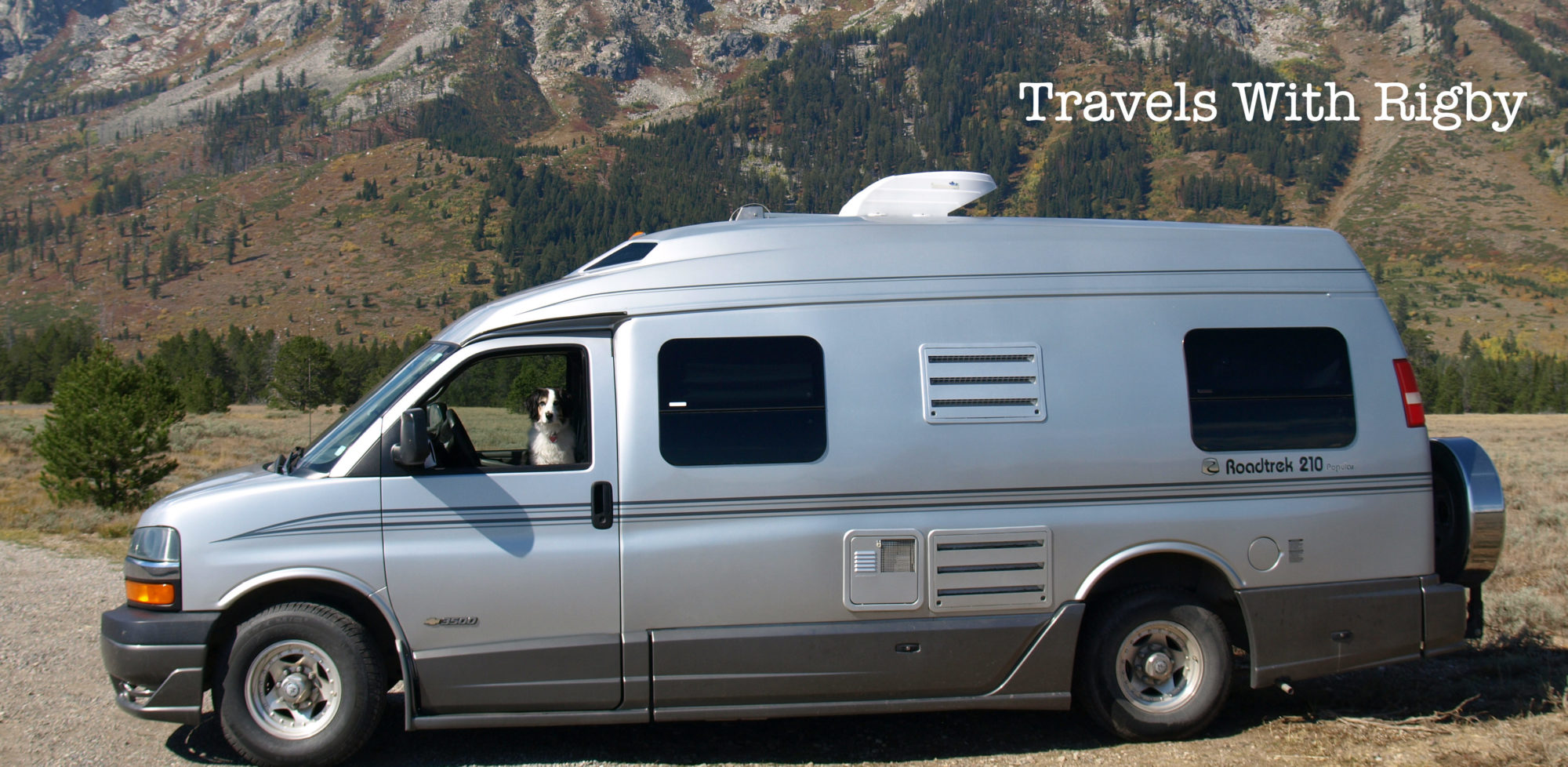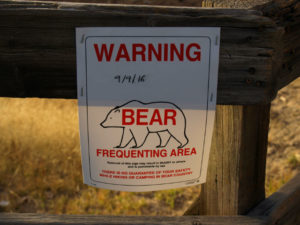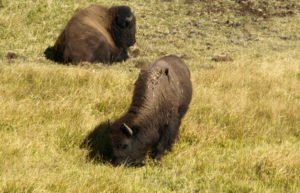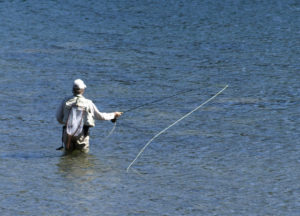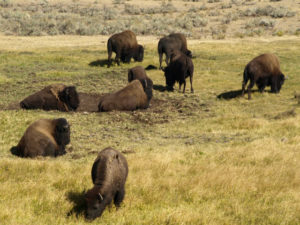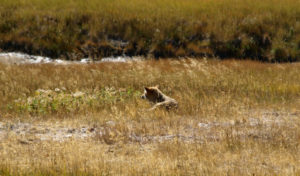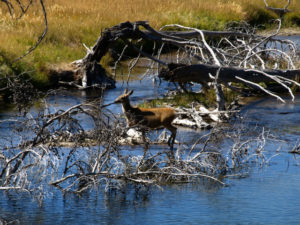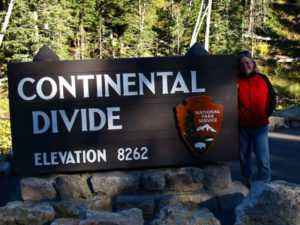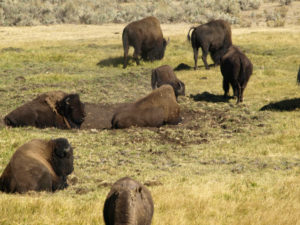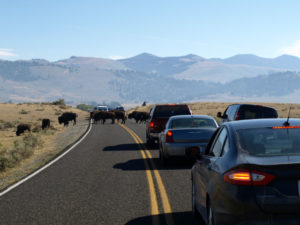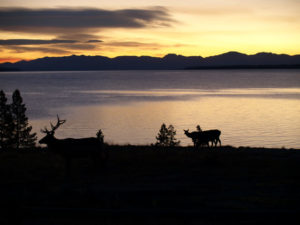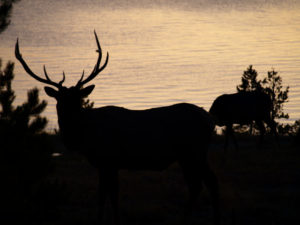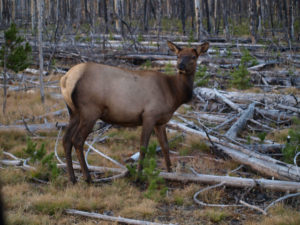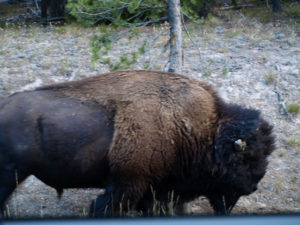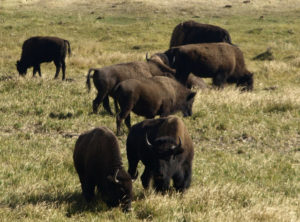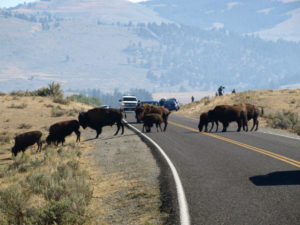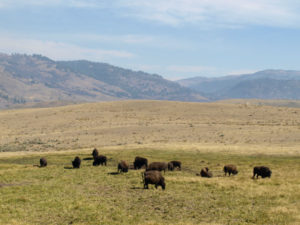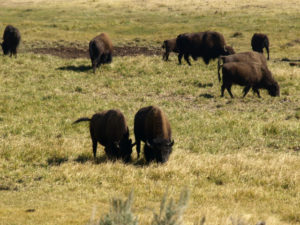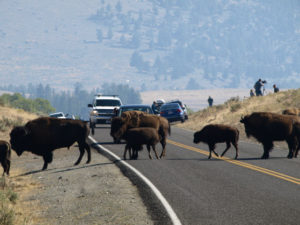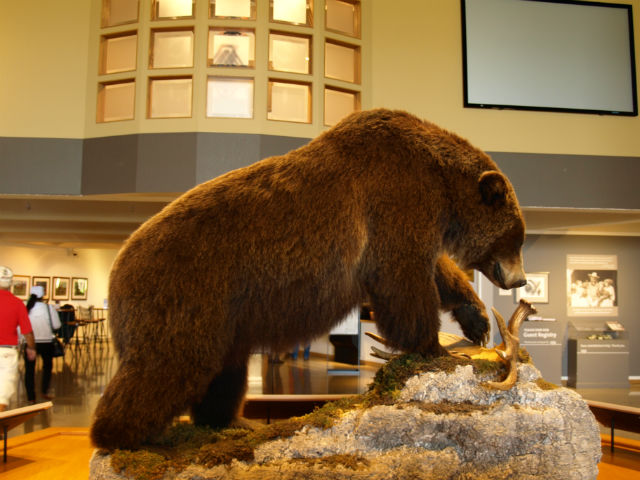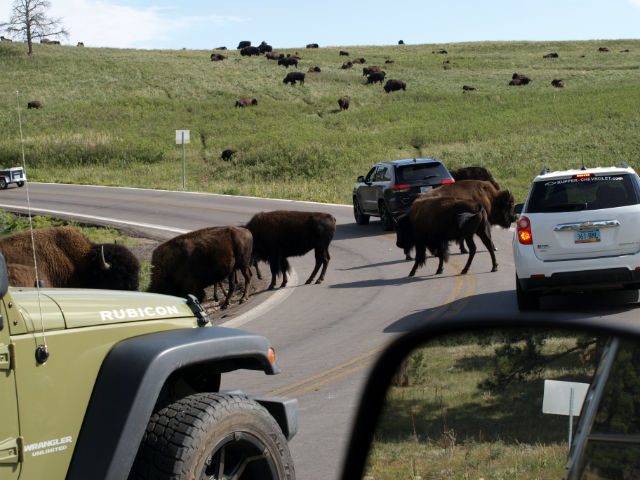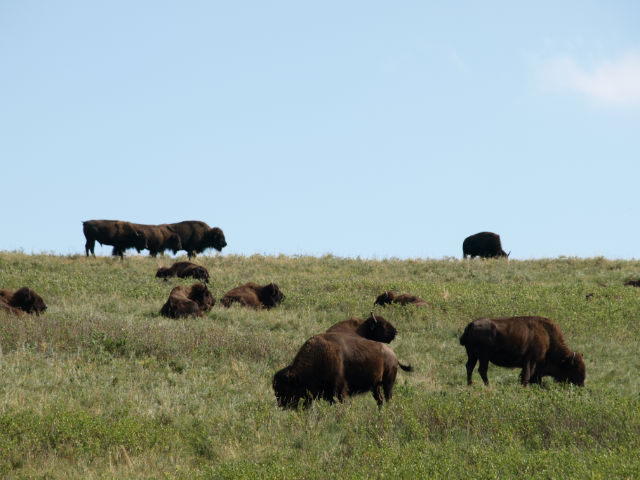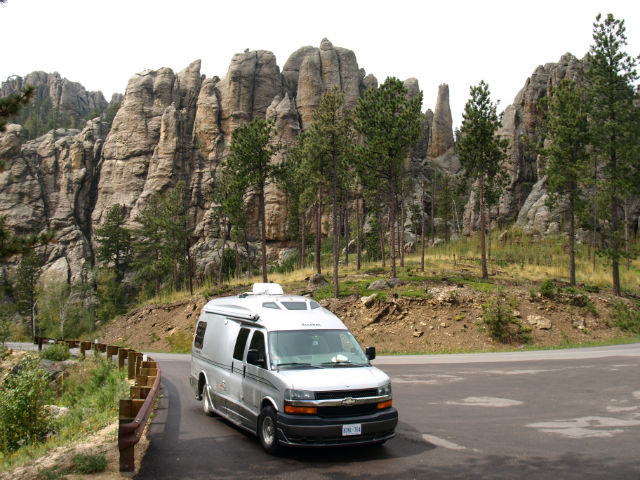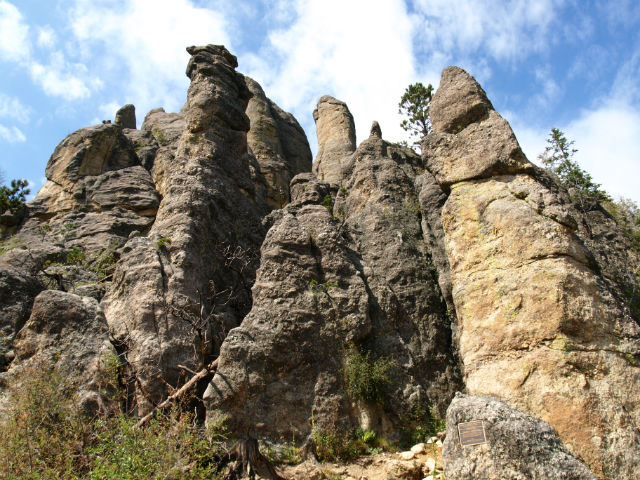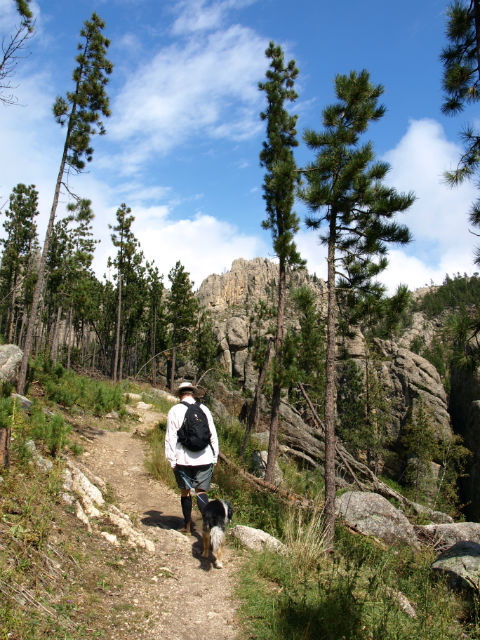Tag Archives: bison
(Almost) blasé about bison
We got our first idea of the Yellowstone wildlife to expect back in Cody, WY at the amazing Buffalo Bill Center of the West. In the Draper National History section there were detailed explanations of the various landscapes that make up the Greater Yellowstone region – the more open Northern Range, the lodgepole pine forests (they cover 80% of the parkland), the plains (“where the buffalo roam”) and the mountain meadows. It was just the primer we needed before heading into the park.
Signing into the Yellowstone campgrounds involves more than just site assignment. We had to initial a waiver acknowledging that we were in grizzly country. Huge metal food lockers for tenters to use. Lots of bear information – the what-to-do-if scenarios. Dogs are not allowed on the hiking trails (sorry Rigby) although it’s pretty easy to understand.
Now that we’re here, we’ve seen lots of wildlife (although not the elusive gray wolf nor the grizzly). So many bison that after a day or two you start to get blasé about the experience. Ditto for the elk – although we did have a magical early morning viewing of elk silhouetted against the sunrise that will be forever imprinted on our brains. There have been many deer and a coyote snoozing in the field between the geysers. One, lonely bighorn sheep (“the master of the mountain”) nibbling on some grass and a flock of snow white pelicans fishing in the Yellowstone River. At the museum we learned that the bighorn sheep have air filled chambers in their skulls to absorb head-on-blows.
On the second day in Yellowstone, we set our alarm for 6am and were on the road 15 minutes later – freshly-brewed coffee in hand – for a day devoted to wildlife watching (gotta love the Roadtrek – it really is up-and-out in no time). Luckily, the day we chose was the one day we’ve had here with clear blue skies from start to finish.
We were barely out of the campground when we came across the harem of elk, with the sun just barely coming up behind the Absaroka Mountain Range to the east. We stopped and just watched for a good 10 minutes. What a way to start the morning!
Our goal for the day were the wildlife rich Hayden and Lamar Valleys – more open grasslands favoured by the larger animals, like the bison. And we wanted to get there early, before the car traffic started to clog the roadways.
It wasn’t long before we were slowed to a crawl by our first bison jam. These iconic symbols of the West can weight 2,000 lbs and charge at 30 mph (you and me can run – maybe – 10 mph, so you do the math). If they decide to cross the road, there’s no argument.
In the early 1800s there were an estimated 60 million bison roaming the Great Plains of the West. They were hunted so intensely that they were almost wiped out – by 1890 there were fewer than a thousand left. The Yellowstone herd was protected in the early 1900s and has now grown to a herd of about 4,000.
The Lamar Valley and the Northern Range are much more open, fewer trees, more grasslands and high plateaus peppered with sagebrush. This open topography is favoured by the bison and by the grizzlies. Saw the former (in spades), still looking for the latter. Black bears prefer the mix of woods and meadows.
When you come to Yellowstone and are looking for wildlife, here’s where you want to go:
- Lamar Valley and Hayden Valley – elk and bison
- Yellowstone River – fly fishing (catch and release only) and white pelican flocks
- Northern Range – gray wolves and bear (black and grizzly), bison, elk, deer and pronghorn antelope
We’ve posted a separate photos-only piece about Yellowstone wildlife. Have a look. Have you been to Yellowstone? If so, what wildlife did you come across?
Black Hills, Bison & Custer
We travelled further west along I-90 into the South Dakota Black Hills, an area best known for wildlife and Mt. Rushmore (did the obligatory stop; it’s striking, but it didn’t hold our attention for long). The Black Hills tend to get overshadowed by the “wow” factor of the dramatic Badlands but we found it just as beautiful and just as wild, in its own way.
We camped (at the lovely Stockdale South Campground) and explored the Black Hills’ Custer State Park, South Dakota’s first state park and a don’t-miss stop. If you go this way, head into the excellent Visitor Center for information and a breathtaking widescreen movie about the region (got lots of background that helped us map out the next few days). Kevin Costner narrates, which doesn’t hurt things either!
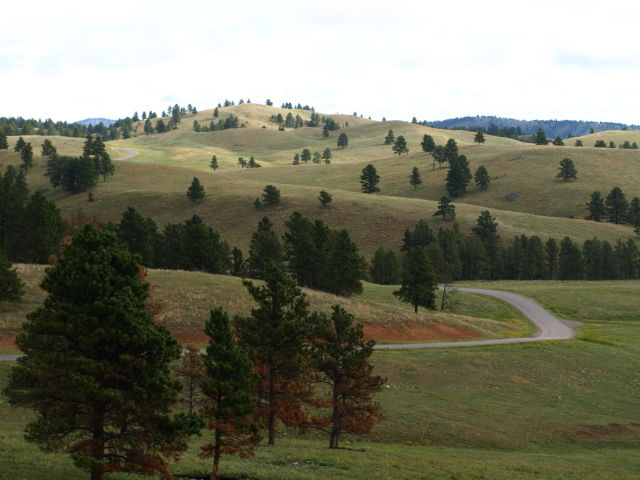
Over the following days, we drove all the major scenic roads (which is, like, every single roadway): Iron Mountain Road with its pig-tail bridges (held up en route by a bison jam), Wildlife Loop Road, the drive to Wind Cave National Park and the nail-biting, hand-wringing, seat-clutching twists and turns of the narrow Needles Highway to the north. The latter involved three low and narrow tunnels cut into the rock that had us pulling out a tape measure first. Not kidding.
The Lakota called this land the “hills of black,” hence the name. There is a beautiful, pleasing roll to the land; the hills are covered with dark green ponderosa pine, the air is sweet with its fragrance and around every turn you’re likely to see deer, prairie dogs, elk, prairie dogs, pronghorn antelope, bison and maybe even . . . prairie dogs.
Custer State Park protects the American prairie bison. In the early 1800s, there were an estimated 30 to 60 million of the massive creatures. By the 1890s they’d been hunted down to near extinction – fewer than 1,000. Now, protected, there are 400 bison born at the park every year. The numbers are climbing and the main herd struts down the roadways like they own the place. Rigby was very interested.
Further to the south, Wind Cave National Park is “one of the biggest pieces of Swiss cheese you’ll see.” The park protects the underground cave environment known as one of the few places in the world where there are large rock formations of boxwork. To the Lakota, Wind Cave is a sacred spot – the place marking the emergence of their people into the world above.
People kept telling us not to miss the Needles Highway. This would be immediately followed by clucking about how low and narrow the rock tunnels are. This was followed by the tape measure. In the end, we decided “nothing ventured, nothing gained” and it turned out that we made it through with no problems.
It is a spectacular drive. Twists and turns, lots of lookouts and drop-offs. Beautiful views of the Black Hills and towering granite spires that give the roadway its name. We stopped and did a hike along the Cathedral Spires Trail. Most of the way in the weather started to turn (that happens incredibly quickly here) and we cut it short and went back to the van. Getting caught in the mountains in fog and rain . . . not such a good thing.
But those Black Hills – they are high on our list of places to visit again and again.
